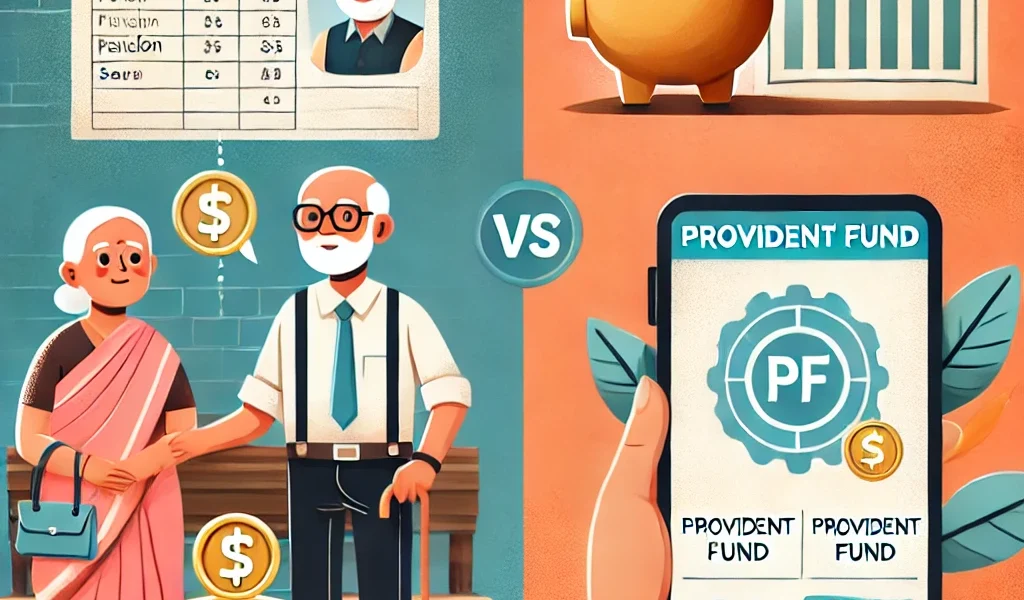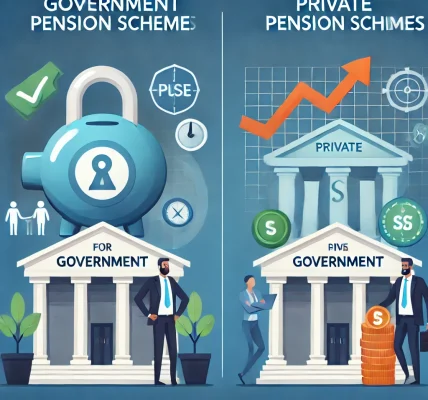Introduction
Financial security after retirement is a major concern for working professionals. To address this, the government and private institutions offer various schemes, including Pension Schemes and Provident Funds. While both aim to provide financial stability post-retirement, they function differently.
In this article, we will explore the key differences between Pension and Provident Fund, how they work, and which option may be better suited for your retirement planning.
1. What is a Pension Scheme?
A Pension Scheme is a financial plan that provides individuals with a regular income after retirement. It is designed to ensure a continuous cash flow even after you stop working.
Types of Pension Schemes in India
- Government Pension Schemes
- National Pension System (NPS)
- Atal Pension Yojana (APY)
- Employees’ Pension Scheme (EPS) (Part of EPF)
- Old Pension Scheme (OPS) (For government employees)
- Private Pension Plans
- Insurance-based pension plans from LIC, HDFC Life, ICICI Prudential, etc.
- Mutual fund-based retirement plans
Key Features of Pension Schemes
- Regular monthly income after retirement
- Contributions can be voluntary (NPS) or employer-mandated (EPS)
- Lump sum withdrawal option (partially)
- Annuity-based payouts (lifetime pension)
- Tax benefits under Section 80C and 80CCD(1B) of the Income Tax Act
2. What is a Provident Fund (PF)?
A Provident Fund (PF) is a retirement savings scheme where both the employer and employee contribute a fixed percentage of the salary. The fund accumulates over time and provides a lump sum amount upon retirement.
Types of Provident Funds in India
- Employees’ Provident Fund (EPF)
- Mandatory for salaried employees working in organizations with more than 20 employees.
- Employee contributes 12% of basic salary, and employer contributes the same.
- EPFO (Employees’ Provident Fund Organization) manages it.
- Public Provident Fund (PPF)
- Voluntary savings scheme open to all Indian citizens.
- Offers a fixed return (interest rate set by the government quarterly).
- Lock-in period of 15 years, extendable in blocks of 5 years.
- Voluntary Provident Fund (VPF)
- Extension of EPF where an employee voluntarily contributes more than 12%.
- Employer is not obligated to contribute additional amounts.
Key Features of Provident Fund
- Lump sum withdrawal after retirement or specific tenure.
- Tax-free interest and maturity benefits (subject to conditions).
- Higher returns in long-term savings (especially in EPF & PPF).
- Withdrawals allowed for emergencies like medical needs, education, home purchase, etc.
3. Key Differences Between Pension and Provident Fund
| Feature | Pension Scheme | Provident Fund |
|---|---|---|
| Nature | Provides a regular income after retirement | One-time lump sum payout after retirement |
| Objective | Financial security for life post-retirement | Long-term savings & wealth creation |
| Who Contributes? | Employer and/or Employee | Employer and Employee (EPF), Individual (PPF) |
| Returns | Varies based on annuity choice (NPS, EPS) | Fixed returns (PPF), market-linked (EPF) |
| Tax Benefits | Deductions under Section 80C & 80CCD | Tax-free returns on PPF & EPF under Section 80C |
| Withdrawal Rules | Limited lump sum withdrawal; monthly annuity | Full withdrawal allowed after maturity/retirement |
| Best For | Regular post-retirement income | Wealth accumulation for long-term financial goals |
4. Which One is Better: Pension or Provident Fund?
Choose Pension Scheme If:
✅ You want a steady income after retirement rather than a lump sum. ✅ You are looking for government-backed security (like NPS, EPS). ✅ You prefer structured payouts rather than managing a large corpus yourself.
Choose Provident Fund If:
✅ You prefer a lump sum amount to use for investment, business, or personal expenses. ✅ You want tax-free and risk-free returns (especially PPF & EPF). ✅ You need flexibility in withdrawals (PPF allows partial withdrawals for emergencies).
5. Can You Have Both Pension and Provident Fund?
Yes, you can invest in both! Many salaried employees have EPF (for savings) and EPS (for pension benefits). Similarly, you can combine NPS with PPF to balance your retirement portfolio.
Best Combination for Retirement Planning:
✔ EPF + EPS (For salaried employees in the private sector) ✔ NPS + PPF (For additional retirement savings and tax benefits) ✔ VPF + Mutual Fund Pension Plan (For higher growth and flexibility)
6. Tax Benefits Comparison
| Scheme | Tax Benefit on Investment | Tax on Maturity | Tax on Withdrawal |
| NPS | 80CCD(1B) (up to ₹50,000 extra) | 40% tax-free, rest taxable | Monthly pension is taxable |
| EPS | Not applicable | Pension amount taxable | Monthly pension is taxable |
| EPF | 80C (up to ₹1.5 lakh) | Tax-free after 5 years | Tax-free if withdrawn after 5 years |
| PPF | 80C (up to ₹1.5 lakh) | Completely tax-free | Tax-free |
Conclusion: Which Should You Choose?
There is no one-size-fits-all answer to whether a pension scheme or a provident fund is better. The ideal choice depends on your financial goals, risk appetite, and need for post-retirement security.
Final Recommendation:
✔ If you need monthly financial security, go for a Pension Scheme like NPS or EPS. ✔ If you want high returns with flexibility, choose Provident Fund (PPF/EPF). ✔ The best strategy is to invest in both for a balanced and secure retirement.
By understanding these financial tools, you can make an informed decision to build a secure and stress-free retirement. Start planning today! 💰😊
FAQs
1. Can I withdraw my pension fund early?
👉 No, most pension schemes do not allow early withdrawal except in case of severe health conditions or death.
2. What happens to my provident fund after I retire?
👉 You can withdraw the entire provident fund as a lump sum and invest it as per your needs.
3. Which is better for tax savings: PPF or NPS?
👉 PPF is completely tax-free, whereas NPS has some taxable components. If you want 100% tax savings, PPF is better.
4. Can I have both EPF and PPF accounts?
👉 Yes, both are allowed and offer great long-term savings benefits.
5. Is pension income taxable?
👉 Yes, monthly pension income is taxable under the Income Tax Act, depending on your tax slab.




